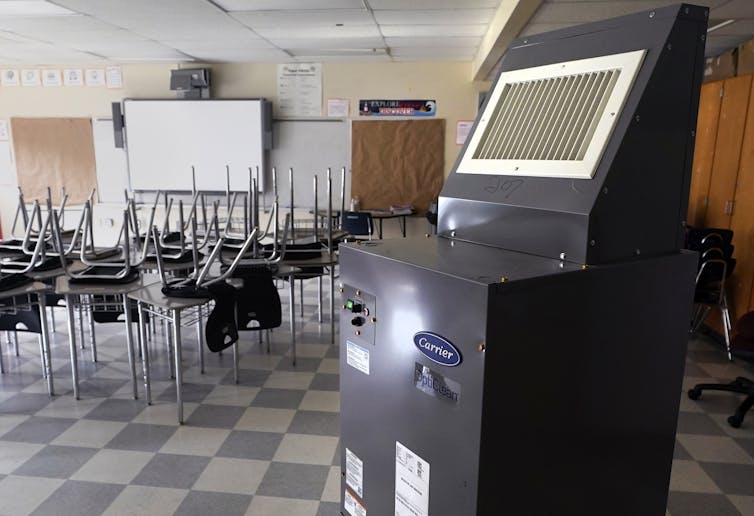Ventilation and clean air are wins on many different levels
Patricia Fabian, Boston University and Jonathan Levy, Boston University
 |
| An air scrubber in a classroom at the E.N. White School in Holyoke, Mass. AP Photo/Charles Krupa |
Fall 2022 marks the start of the fourth school year affected by the COVID-19 pandemic, which has spotlighted the importance of indoor air quality in schools. Ideally, all school buildings would have adequate ventilation, filtered air in each classroom and windows that open.
Sadly, this is not the case – and indoor air quality in many schools is poor as a result. This is especially problematic in the wake of the U.S. Centers for Disease Control and Prevention’s August 2022 COVID-19 guidance for schools, which scales back other measures for limiting transmission, such as masking, testing and quarantining.
Beyond minimizing COVID-19 transmission, indoor air quality also matters for student academic performance. This is especially important given the learning losses that many children experienced in the first two years of the pandemic. Hot, stuffy classrooms make it harder for students to learn. So do cold classrooms.
Our research focuses on indoor environments and health – an area that has received increased attention during the pandemic, since most COVID-19 transmission occurs through shared air indoors. There is ample evidence that smart investments in school buildings can reduce transmission of infectious disease, while also improving learning and increasing well-being for students, teachers and administrators.
Many school districts have limited resources and buildings in poor condition. Where should they start? Here are some priorities we see for immediate action and longer-term investments that can truly transform the school experience.
Filters and fresh air
Since the spring of 2020, schools have invested millions of dollars in interventions to reduce COVID-19 transmission, including high-efficiency, free-standing commercial filter units and ventilation upgrades. These actions are a drop in the bucket, given the structural improvements needed in many schools, especially in less wealthy school districts, but they are an important start. And their benefits extend beyond COVID-19, so they should not be discarded.
For example, high-efficiency filters – including commercial units, DIY boxes or filters with ratings of MERV-13 for HVAC systems – capture flu and common cold viruses as well as SARS-CoV-2 virus particles. They also clean the air of pollen particles, mold spores and pollution from car exhaust and industrial operations. And in areas where wildfires are common, filters reduce the concentration of smoke particles inside buildings.
Schools with mechanical ventilation have been able to increase the amount of filtered fresh air that these systems pull indoors. This dilutes all indoor pollutants. For kids and school staff, particularly those with asthma, allergies and sensitivities, this can mean fewer missed days of school, less medication, and fewer asthma attacks and subsequent trips to the hospital.
Improved ventilation can actually increase learning and attention. A 2010 study showed that kids performed better on standardized tests when ventilation rates were higher. Poor ventilation may also affect teachers: A 2016 study found that office workers’ cognitive performance improved when they were exposed to lower carbon dioxide levels, which is a marker of better ventilation. And a 2018 analysis showed that students’ performance on school tests declined on hot days, especially in schools without air conditioning. If you’ve ever felt that it was hard to concentrate in a hot, stuffy room, the science backs you up.
For now, we recommend that schools that have put improvements in place should maintain increased ventilation rates with maximum fresh air, continue to use high-efficiency filters in their HVAC systems and keep free-standing filters running in classrooms. Schools that have not invested in these steps should do so, with states providing funding to lower-resourced districts as needed. The costs of these steps are modest compared with the benefits they provide for health and learning.
Families and staff who want to improve conditions in their schools should focus on providing every classroom with improved ventilation and filtration, including building DIY boxes, if necessary.
Funding for healthier buildings
These near-term solutions can help, but the best way to ensure that schools provide healthy conditions for learning is by investing in healthier buildings.
Funds for this purpose are available now. All U.S. states have received millions of dollars from the American Rescue Plan, enacted in 2021 to address the impact of COVID-19, including Elementary and Secondary Schools Emergency Relief, or ESSER, funds. The Department of Education has disbursed US$122 billion to help schools prevent the spread of COVID-19 and operate safely.
School districts have used this money to address a variety of needs, including staffing, academic support and mental health, but much of it is still available. And only a handful of states have invested in HVAC. According to a review by the independent Brookings Institution, less than 5% of the money from the most recent round of ESSER funds had been spent through the first quarter of 2022.
Another $3 billion was authorized in the recently enacted Inflation Reduction Act for environmental and climate justice block grants. These can be used to upgrade buildings and ventilation systems to reduce indoor air pollution.
School districts may be tempted to put indoor air interventions on the back burner, given widespread perceptions that the pandemic is over and the many other challenges they face. But in our view, other educational interventions will be less effective if kids are frequently absent due to illness or unable to concentrate in the classroom.
We believe it is important for families and staff to understand the benefits that healthy indoor learning environments offer to everyone who spends time in school buildings, and to hold states and school districts accountable for investing now in HVAC improvements for healthier school buildings.![]()
Patricia Fabian, Associate Professor of Environmental Health, Boston University and Jonathan Levy, Professor and Chair, Department of Environmental Health, Boston University
This article is republished from The Conversation under a Creative Commons license. Read the original article.